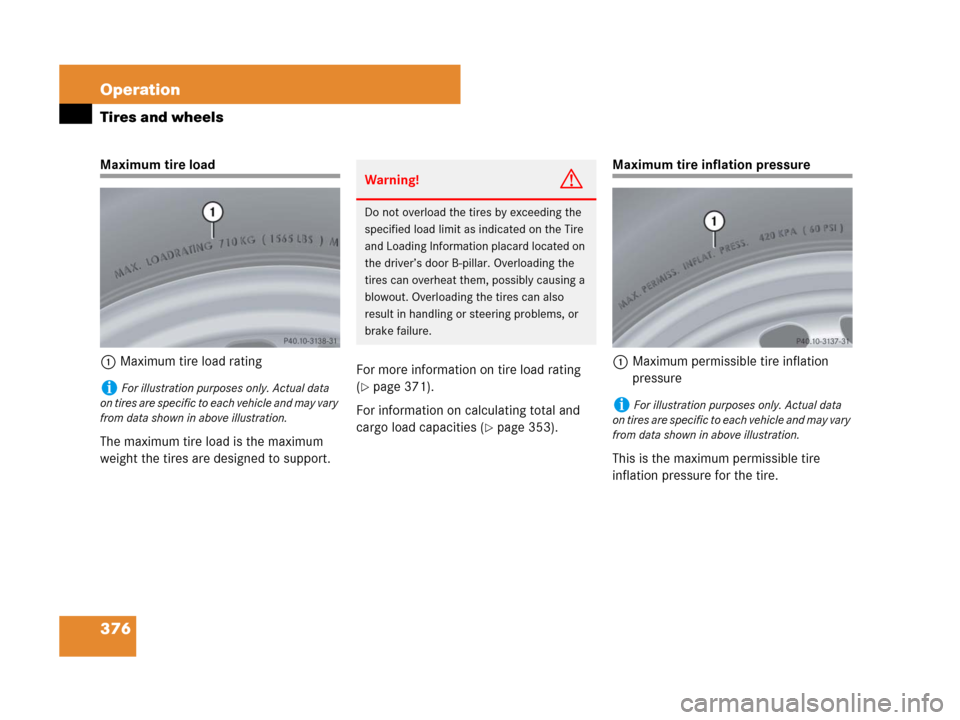Page 370 of 561

369 Operation
Tires and wheels
�Press buttonæ.
The following message will appear in
the multifunction display:
Tire Pressure Monitor
Restarted
After a few minutes driving, the current
tire inflation pressure values are ac-
cepted as reference values and then
monitored.
If you wish to cancel activation:
�Press buttonç.Potential problems associated with
underinflated and overinflated tires
Underinflated tires
Underinflated tires can:
�cause excessive and uneven tire wear
�adversely affect fuel economy
�lead to tire failure from being
overheated
�adversely affect handling
characteristicsOverinflated tires
Overinflated tires can:
�adversely affect handling
characteristics
�cause uneven tire wear
�be more prone to damage from road
hazards
�adversely affect ride comfort
�increase stopping distance
Warning!G
Follow recommended tire inflation
pressures.
Do not underinflate tires. Underinflated tires
wear excessively and/or unevenly,
adversely affect handling and fuel economy,
and are more likely to fail from being
overheated.
Warning!G
Follow recommended tire inflation
pressures.
Do not overinflate tires. Overinflated tires
can adversely affect handling and ride
comfort, wear unevenly, increase stopping
distance, and result in sudden deflation
(blowout) because they are more likely to
become punctured or damaged by road
debris, potholes etc.
Page 371 of 561

370 Operation
Tires and wheels
Tire labeling
Besides tire name (sales designation) and
manufacturer name, a number of markings
can be found on a tire.
Following are some explanations for the
markings on your vehicle’s tires:1Uniform Quality Grading Standards
(
�page 377)
2DOT, Tire Identification Number (TIN)
(
�page 374)
3Maximum tire load (
�page 376)
4Maximum tire inflation pressure
(
�page 376)
5Manufacturer
6Tire ply material (
�page 379)
7Tire size designation, load and speed
rating (
�page 370)
8Load identification (
�page 374)
9Tire nameTire size designation, load and speed
rating
1Tire width
2Aspect ratio in %
3Radial tire code
4Rim diameter
5Tire load rating
6Tire speed rating
iFor illustration purposes only. Actual data
on tires are specific to each vehicle and may vary
from data shown in above illustration.
For more information, see “Rims and tires”
(
�page 515).
iFor illustration purposes only. Actual data
on tires are specific to each vehicle and may vary
from data shown in above illustration.
Page 372 of 561

371 Operation
Tires and wheels
General:
Depending on the design standards used,
the tire size molded into the sidewall may
have no letter or a letter preceding the tire
size designation.
No letter preceding the size designation
(as illustrated above): Passenger car tire
based on European design standards.
Letter “P” preceding the size designation:
Passenger car tire based on U.S. design
standards.
Letter “LT” preceding the size designation:
Light Truck tire based on U.S. design
standards.
Letter “T” preceding the size designation:
Temporary spare tires which are high
pressure compact spares designed for
temporary emergency use only.Tire width
The tire width1 (
�page 370) indicates
the nominal tire width in mm.
Aspect ratio
The aspect ratio2 (
�page 370) is the
dimensional relationship between tire
section height and section width and is
expressed in percentage. The aspect ratio
is arrived at by dividing section height by
section width.
Tire code
The tire code3 (
�page 370) indicates
the tire construction type. The “R” stands
for radial tire type. Letter “D” means diag-
onal or bias ply construction; letter “B”
means belted-bias ply construction.
At the tire manufacturer’s option, any tire
with a speed capability above 149 mph
(240 km/h) can include a “ZR” in the size
designation (for example: 245/40 ZR 18).
For additional information, see “Tire speed
rating” (
�page 372).Rim diameter
The rim diameter4 (
�page 370) is the
diameter of the bead seat, not the
diameter of the rim edge. Rim diameter is
indicated in inches (in).
Tire load rating
The tire load rating5 (
�page 370) is a
numerical code associated with the
maximum load a tire can support.
For example, a load rating of 91 corre-
sponds to a maximum load of 1 356 lbs
(615 kg) the tire is designed to support.
See also “Maximum tire load”
(
�page 376) where the maximum load as-
sociated with the load index is indicated in
kilograms and lbs.
Page 375 of 561

374 Operation
Tires and wheels
Load identification
1Load identificationIn addition to tire load rating, special load
identification1 may be molded into the
tire sidewall following the letter designat-
ing the tire speed rating (
�page 370).
No specification given: absence of any text
(like in above example) indicates a
standard load (SL) tire.
XL or Extra Load: designates an extra load
(or reinforced) tire.
Light Load: designates a light load tire.
C, D, E: designates load range associated
with the maximum load a tire can carry at
a specified pressure.
DOT, Tire Identification Number (TIN)
U.S. tire regulations require each new tire
manufacturer or tire retreader to mold a
TIN into or onto a sidewall of each tire
produced.
The TIN is a unique identifier which facili-
tates efforts by tire manufactures to notify
purchasers in recall situations or other
safety matters concerning tires and gives
purchasers the means to easily identify
such tires.
The TIN is comprised of “Manufacturer’s
identification mark”, “Tire size”, “Tire type
code” and “Date of manufacture”.
iFor illustration purposes only. Actual data
on tires are specific to each vehicle and may vary
from data shown in above illustration.
Page 377 of 561

376 Operation
Tires and wheels
Maximum tire load
1Maximum tire load rating
The maximum tire load is the maximum
weight the tires are designed to support.For more information on tire load rating
(
�page 371).
For information on calculating total and
cargo load capacities (
�page 353).
Maximum tire inflation pressure
1Maximum permissible tire inflation
pressure
This is the maximum permissible tire
inflation pressure for the tire.
iFor illustration purposes only. Actual data
on tires are specific to each vehicle and may vary
from data shown in above illustration.
Warning!G
Do not overload the tires by exceeding the
specified load limit as indicated on the Tire
and Loading Information placard located on
the driver’s door B-pillar. Overloading the
tires can overheat them, possibly causing a
blowout. Overloading the tires can also
result in handling or steering problems, or
brake failure.
iFor illustration purposes only. Actual data
on tires are specific to each vehicle and may vary
from data shown in above illustration.
Page 378 of 561

377 Operation
Tires and wheels
Always follow the recommended tire
inflation pressure (
�page 357) for proper
tire inflation.Uniform Tire Quality Grading Standards (U.S. vehicles)
Tire manufacturers are required to grade
tires based on three performance factors:
treadwear, traction and
temperature resistance.
1Treadwear
2Traction
3Temperature resistanceQuality grades can be found, where appli-
cable, on the tire sidewall between tread
shoulder and maximum section width. For
example:
All passenger car tires must conform to
federal safety requirements in addition to
these grades.
Warning!G
Never exceed the max. tire inflation
pressure. Follow recommended tire inflation
pressures.
Do not underinflate tires. Underinflated tires
wear excessively and/or unevenly,
adversely affect handling and fuel economy,
and are more likely to fail from being over-
heated.
Do not overinflate tires. Overinflated tires
can adversely affect handling and ride com-
fort, wear unevenly, increase stopping dis-
tance, and result in sudden deflation
(blowout) because they are more likely to
become punctured or damaged by road de-
bris, potholes etc.
iFor illustration purposes only. Actual data
on tires are specific to each vehicle and may vary
from data shown in above illustration.
TreadwearTractionTemperature
200AAA
Page 380 of 561

379 Operation
Tires and wheels
Tire ply material
1Plies in sidewall
2Plies under tread
This marking tells you about the type of
cord and number of plies in the sidewall
and under the tread.Tire and loading terminology
Accessory weight
The combined weight (in excess of those
standard items which may be replaced) of
automatic transmission, power steering,
power brakes, power windows, power
seats, radio, and heater, to the extent that
these items are available as
factory-installed equipment (whether
installed or not).
Air pressure
The amount of air inside the tire pressing
outward on each square inch of the tire.
Air pressure is expressed in pounds per
square inch (psi), or kilopascal (kPa) or
bars.
Aspect ratio
Dimensional relationship between tire
section height and section width
expressed in percentage.
Warning!G
The temperature grade for this tire is estab-
lished for a tire that is properly inflated and
not overloaded. Excessive speed, underin-
flation, or excessive loading, either sepa-
rately or in combination, can cause
excessive heat build-up and possible tire
failure.
iFor illustration purposes only. Actual data
on tires are specific to each vehicle and may vary
from data shown in above illustration.
Page 381 of 561

380 Operation
Tires and wheels
Bar
Another metric unit for air pressure. There
are 14.5038 pounds per square inch (psi)
to 1 bar; there are 100 kilopascals (kPa)
to 1 bar.
Bead
The tire bead contains steel wires wrapped
by steel cords that hold the tire onto the
rim.
Cold tire inflation pressure
Tire inflation pressure when your vehicle
has been sitting for at least 3 hours or
driven no more than 1 mile (1.6 km).
Curb weight
The weight of a motor vehicle with stan-
dard equipment including the maximum
capacity of fuel, oil, and coolant, and, if so
equipped, air conditioning and additional
optional equipment, but without passen-
gers and cargo.DOT (Department of Transportation)
A tire branding symbol which denotes the
tire meets requirements of the
U.S. Department of Transportation.
GAWR (G
ross Axle Weight Rating)
The GAWR is the maximum permissible
axle weight. The gross vehicle weight on
each axle must never exceed the GAWR for
the front and rear axle indicated on the
certification label located on the driver’s
door B-pillar.
GTW (G
ross Trailer Weight)
The GTW is the weight of the trailer plus
the weight of all cargo, equipment, luggage
etc. loaded on the trailer.GVW (G
ross Vehicle Weight)
The GVW comprises the weight of the
vehicle including fuel, tools, spare wheel,
installed accessories, passengers and
cargo and, if applicable, trailer tongue
load. The GVW must never exceed the
GVWR indicated on the certification label
located on the driver’s door B-pillar.
GVWR (G
ross Vehicle Weight Rating)
This is the maximum permissible vehicle
weight of the fully loaded vehicle (weight of
the vehicle including all options, passen-
gers, fuel, and cargo and, if applicable,
trailer tongue load). It is indicated on
certification label located on the driver’s
door B-pillar.
Kilopascal (kPa)
The metric unit for air pressure. There are
6.9 kPa to 1 psi; another metric unit for air
pressure is bars. There are 100 kilopascals
(kPa) to 1 bar.